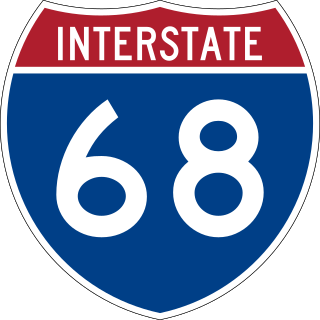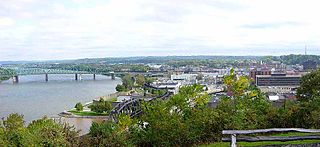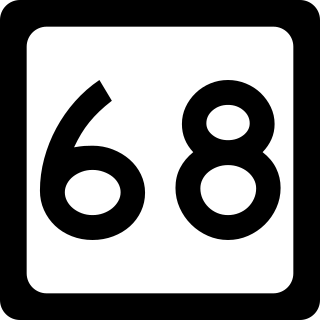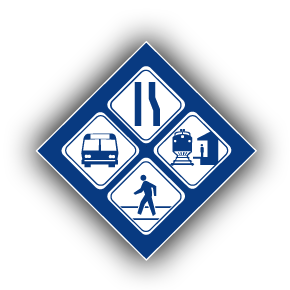
Interstate 68 (I-68) is a 113.15-mile (182.10 km) Interstate Highway in the U.S. states of West Virginia and Maryland, connecting I-79 in Morgantown, West Virginia, east to I-70 in Hancock, Maryland. I-68 is also Corridor E of the Appalachian Development Highway System (ADHS). From 1965 until the freeway's construction was completed in 1991, it was designated as U.S. Route 48 (US 48). In Maryland, the highway is known as the National Freeway, an homage to the historic National Road, which I-68 parallels between Keysers Ridge and Hancock. The freeway mainly spans rural areas and crosses numerous mountain ridges along its route. A road cut at Sideling Hill exposed geological features of the mountain and has become a tourist attraction.

Preston County is a county located in the U.S. state of West Virginia. As of the 2020 Census, the population was 34,216. Its county seat is Kingwood. The county was formed from Monongalia County in 1818 and named for Virginia Governor James Patton Preston.

Parkersburg is a city in and the county seat of Wood County, West Virginia, United States. Located at the confluence of the Ohio and Little Kanawha rivers, it is the state's fourth-most populous city and the center of the Parkersburg–Vienna metropolitan area. The city's population was 29,749 at the 2020 census, and its metro population was 89,490. The city is about 14 miles (23 km) south of Marietta, Ohio.
In the United States, Corridor D is part of the Appalachian Development Highway System. In Ohio, it follows State Route 32 from the eastern Cincinnati suburbs until a point west of Albany, where it becomes concurrent with U.S. Route 50. After crossing into West Virginia, it follows U.S. Route 50 until the Interstate 79 interchange in Clarksburg.

The West Virginia House of Delegates is the lower house of the West Virginia Legislature. Only three states—Maryland, Virginia and West Virginia—refer to their lower house as the House of Delegates.

West Virginia's 2nd congressional district consists of the northern half of the state. It contains Barbour, Berkeley, Brooke, Doddridge, Grant, Hampshire, Hancock, Hardy, Harrison, Jefferson, Lewis, Marion, Marshall, Mineral, Monongalia, Morgan, Ohio, Pleasants, Preston, Randolph, Ritchie, Taylor, Tucker, Tyler, Upshur, Wetzel, and Wood counties.

West Virginia's 1st congressional district is currently located in the southern half of the state.

West Virginia Route 68 is a north–south state highway in northwest West Virginia. The southern terminus of the route is at West Virginia Route 2 on the southern outskirts of Ravenswood. The northern terminus is at Interstate 77/WV 2 exit 179 northeast of Parkersburg. WV 2, concurrent with I-77 south of this location, departs the expressway and continues north on the same roadway as WV 68.
North Central West Virginia is a region of the U.S. state of West Virginia. The region's largest cities are Morgantown, Fairmont, and Clarksburg.

Interstate 77 (I-77) in the US state of West Virginia is a major north–south Interstate Highway. It extends for 187.21 miles (301.29 km) between Bluefield at the Virginia state line and Williamstown at the Ohio state line.

The Northern Virginia Transportation Authority (NVTA) is a regional governmental entity established to plan, prioritize and fund regional transportation programs. The NVTA covers Arlington, Fairfax, Loudoun and Prince William counties and the cities of Alexandria, Fairfax, Falls Church, Manassas and Manassas Park.

The West Virginian, later known as the Potomac Turbo and Potomac Special, was a daily passenger train operated by Amtrak between Washington, D.C., and Parkersburg, West Virginia. This route was previously served by the Baltimore & Ohio's (B&O) train of the same name, and was the first of several services in the state of West Virginia established at the behest of US Representative Harley Orrin Staggers, the powerful chair of the House Interstate and Foreign Commerce Committee. This patronage earned the train the derisive sobriquets "Harley's Hornet" and the "Staggers Special".

The 2016 West Virginia gubernatorial election took place on November 8, 2016, to elect the Governor of West Virginia, concurrently with the 2016 U.S. presidential election, as well as elections to the United States Senate in other states and elections to the United States House of Representatives and various state and local elections. The primaries were held on May 10.

West Virginia's 2nd Senate district is one of 17 districts in the West Virginia Senate. It is currently represented by Republicans Mike Maroney and Charles H. Clements. All districts in the West Virginia Senate elect two members to staggered four-year terms.
Danielle Walker is an American politician and community activist, who served as a Democratic member of the West Virginia House of Delegates from 2018 until her resignation in 2023. Through her tenure, Walker was the only Black woman serving in the West Virginia Legislature. In June 2022, Walker was elected vice chair of the West Virginia Democratic Party, she later resigned as vice chairwoman after her selection as the leader of the American Civil Liberties Union of West Virginia.
Trenton Carl Barnhart is an American politician who has served as a Delegate from the 7th district to the West Virginia House of Delegates since 2019. Barnhart is a Republican.
Christopher Wayne Toney is an American politician who has served as a Delegate from the 31st District to the West Virginia House of Delegates since 2018. He is a Republican.













